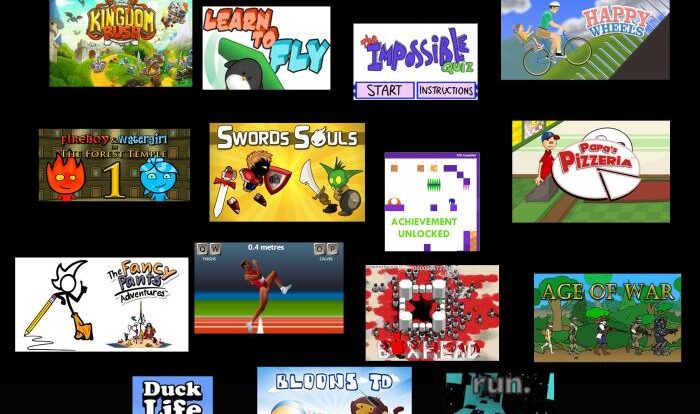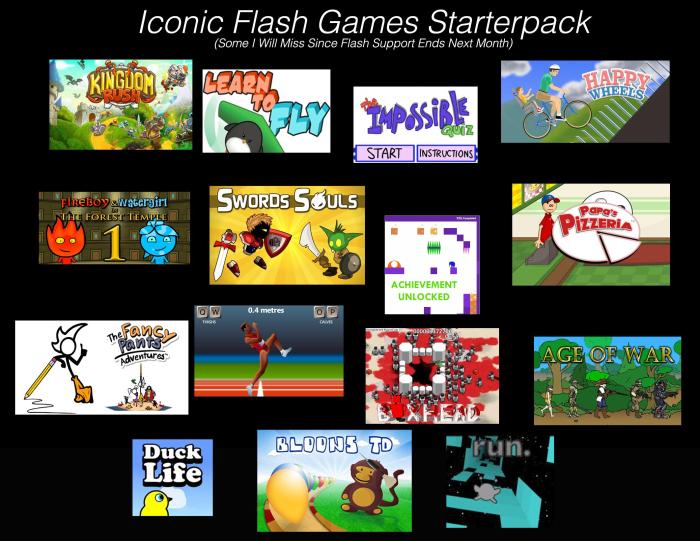
In the realm of digital entertainment, Flash games have left an indelible mark, shaping the gaming landscape and fostering a vibrant online community. From their humble beginnings to their enduring legacy, Flash games have captivated players with their unique blend of accessibility, creativity, and cultural influence.
Born from the ingenuity of Adobe Flash, Flash games emerged as a groundbreaking platform for indie developers to showcase their talents and connect with audiences worldwide. Their small size, browser-based accessibility, and interactive gameplay made them an instant hit, attracting a vast and diverse player base.
History of Flash Games
Flash games emerged in the late 1990s with the advent of Adobe Flash, a multimedia platform that enabled the creation of interactive web content. Flash games gained popularity due to their accessibility, engaging gameplay, and cross-platform compatibility.
Adobe Flash and the Rise of Flash Games
Adobe Flash played a pivotal role in the development of Flash games. Its vector-based graphics and animation capabilities allowed for the creation of visually appealing and dynamic games. Flash games also benefited from Flash’s widespread adoption on web browsers, making them accessible to a vast audience.
Evolution of Flash Games
Over time, Flash games evolved in terms of complexity, gameplay, and storytelling. Early Flash games were often simple and arcade-style, but as the technology matured, more sophisticated and immersive games emerged.
Examples of Popular Flash Games
- Henry Stickmin Collection: A series of interactive adventure games known for its quirky humor and multiple endings.
- Bloons Tower Defense: A strategy game where players defend against waves of balloons using towers with various abilities.
- Super Meat Boy: A challenging platformer known for its precise controls and brutal difficulty.
Key Characteristics of Flash Games
Flash games stand out due to their unique characteristics that set them apart from other game genres. These features contribute to their popularity and accessibility, making them widely enjoyed by gamers of all ages and backgrounds.
Small Size and Browser-Based Accessibility, Flash games
One of the defining traits of Flash games is their compact size. They are typically much smaller in file size compared to console or PC games, allowing for quick loading and easy distribution over the internet. This accessibility makes them suitable for playing on various devices, including computers, laptops, and even mobile phones.
Interactive Gameplay
Flash games prioritize engaging and interactive gameplay. They often feature simple yet addictive mechanics that can be easily grasped by players. This accessibility allows for a wide range of game genres, from puzzle and adventure games to action and strategy titles.
The interactive nature of Flash games encourages players to actively participate and make choices that influence the game’s progression.
Vector Graphics and Animations
Flash games are renowned for their vibrant and dynamic visuals. They utilize vector graphics, which allow for smooth and scalable images that can be resized without losing quality. This technology enables Flash games to run seamlessly on different screen resolutions and devices.
Additionally, Flash games often incorporate elaborate animations that enhance the gameplay experience and create visually appealing environments.
Distinction from Other Game Types
Flash games differ from console or PC games in several key aspects. Firstly, they are primarily designed for web browsers, eliminating the need for dedicated gaming consoles or powerful hardware. This accessibility makes Flash games more widely available and accessible to a broader audience.
Furthermore, Flash games typically feature shorter gameplay sessions compared to console or PC games. They are often designed to be played in short bursts, making them ideal for casual gaming or quick entertainment during breaks or while on the go.
Genres and Subgenres of Flash Games
Flash games are classified into various genres and subgenres, each offering unique gameplay experiences and challenges. These categories range from action-packed adventures to mind-bending puzzles and strategic battles.
Action Games
- Run and Gun:Fast-paced games involving shooting and dodging obstacles, e.g., Metal Slug, Contra.
- Beat ’em Ups:Side-scrolling brawlers where players fight waves of enemies, e.g., Streets of Rage, Double Dragon.
- Shoot ’em Ups:Games where players control a ship or vehicle and shoot down enemies, e.g., Gradius, R-Type.
Adventure Games
- Point-and-Click:Games where players interact with the environment by clicking on objects and solving puzzles, e.g., The Secret of Monkey Island, Sam & Max Hit the Road.
- Platformers:Games where players control a character navigating platforms, jumping, and avoiding obstacles, e.g., Super Mario Bros., Sonic the Hedgehog.
- Role-Playing:Games where players create characters and embark on quests, developing their skills and abilities, e.g., Final Fantasy, Dragon Quest.
Puzzle Games
- Match-Three:Games where players match three or more identical items to clear them from the board, e.g., Bejeweled, Candy Crush Saga.
- Tetris-Like:Games where players rotate and drop blocks to create complete lines, e.g., Tetris, Dr. Mario.
- Hidden Object:Games where players search for hidden objects within a scene, e.g., Where’s Waldo?, Mystery Case Files.
Strategy Games
- Tower Defense:Games where players defend their base by building towers that attack enemy units, e.g., Plants vs. Zombies, Kingdom Rush.
- Real-Time Strategy:Games where players control units and resources in real-time to defeat opponents, e.g., StarCraft, Warcraft III.
- Turn-Based Strategy:Games where players take turns moving units and making decisions on a grid-based map, e.g., Civilization, XCOM.
Cultural Impact of Flash Games
Flash games have had a profound impact on popular culture, particularly in the realm of indie game development and the creation of online gaming communities.
Rise of Indie Game Development
Flash’s accessibility and ease of use lowered the barrier to entry for game developers, enabling individuals and small teams to create and distribute their games without the need for extensive resources or technical expertise. This led to the emergence of a vibrant indie game scene, where developers could experiment with innovative ideas and unconventional gameplay mechanics.
Flash games became a fertile ground for creative expression and experimentation, paving the way for the success of indie games on other platforms.
Creation of Online Gaming Communities
Flash games played a pivotal role in the formation of online gaming communities. Platforms like Newgrounds and Kongregate provided spaces where players could discover, share, and discuss Flash games. These communities fostered a sense of belonging and collaboration, encouraging players to connect with like-minded individuals and share their passion for gaming.
Flash games became a catalyst for social interaction and the development of online gaming culture.
Educational and Social Value
Beyond entertainment, Flash games have also had educational and social value. Many Flash games were designed with educational purposes in mind, covering subjects such as math, science, and history. These games provided an engaging and interactive way for students to learn and reinforce concepts.
Additionally, Flash games have been used to raise awareness about social issues and promote positive values, such as environmental protection and cultural understanding.
Examples of Culturally Significant Flash Games
Numerous Flash games have had a significant cultural impact, leaving a lasting legacy in the gaming world. Some notable examples include:
Super Meat Boy
A challenging platformer that showcased innovative gameplay mechanics and a unique art style.
While flash games may have faded in popularity, the concept of earning money through online platforms remains prevalent. Just as flash games once provided a source of entertainment, numerous apps now offer opportunities to generate income through various tasks and activities.
Despite the evolution of digital platforms, the allure of earning money while engaging in enjoyable activities remains a common thread that connects flash games to the modern era of monetized apps.
Angry Birds
A physics-based puzzle game that became a global phenomenon and spawned multiple sequels and merchandise.
Henry Stickmin
A choose-your-own-adventure game that gained popularity for its humor and branching storylines.
Fancy Pants Adventure
A side-scrolling platformer known for its fluid animation and charming visuals.
Geometry Dash
A rhythm-based platformer that tested players’ skills and precision.These Flash games, among many others, have left an enduring mark on popular culture and continue to be enjoyed by gamers worldwide.
The Decline of Flash Games and its Legacy
The decline of Flash games can be attributed to several factors, primarily the rise of mobile gaming and the discontinuation of Adobe Flash.
Mobile Gaming
The advent of smartphones and tablets brought about a paradigm shift in the gaming industry. Mobile games offered convenience, accessibility, and a wider reach than Flash games, which were confined to desktop computers. The proliferation of mobile gaming platforms like the App Store and Google Play made it easier for developers to distribute and monetize their games, further fueling the growth of the mobile gaming market.
Discontinuation of Adobe Flash
In 2017, Adobe announced the discontinuation of Flash Player, citing security concerns and the declining usage of the platform. This decision effectively ended the era of Flash games, as they relied heavily on Flash technology for their development and execution.
Legacy and Influence
Despite their decline, Flash games have left an enduring legacy on the gaming industry. They popularized casual gaming and made games more accessible to a broader audience. Flash games also played a significant role in the development of indie games, providing a platform for aspiring developers to showcase their creativity and reach a global audience.
Preservation and Re-release
Efforts have been made to preserve Flash games and make them accessible to future generations. Initiatives like the Flashpoint Project have archived thousands of Flash games, allowing users to play them in a browser or emulator. Additionally, some popular Flash games have been re-released in other formats, such as HTML5 or mobile apps, ensuring their continued availability and enjoyment.
Ultimate Conclusion

As the digital landscape evolved, so too did the fate of Flash games. The rise of mobile gaming and the discontinuation of Adobe Flash marked a turning point, leading to their decline. Yet, the legacy of Flash games lives on, inspiring future generations of developers and preserving a cherished chapter in gaming history.
Today, preserved and re-released Flash games continue to entertain and remind us of the transformative power of creativity and innovation.





